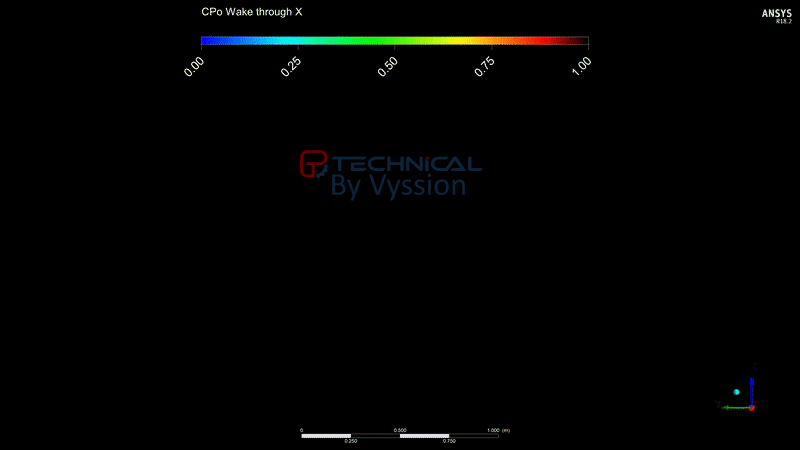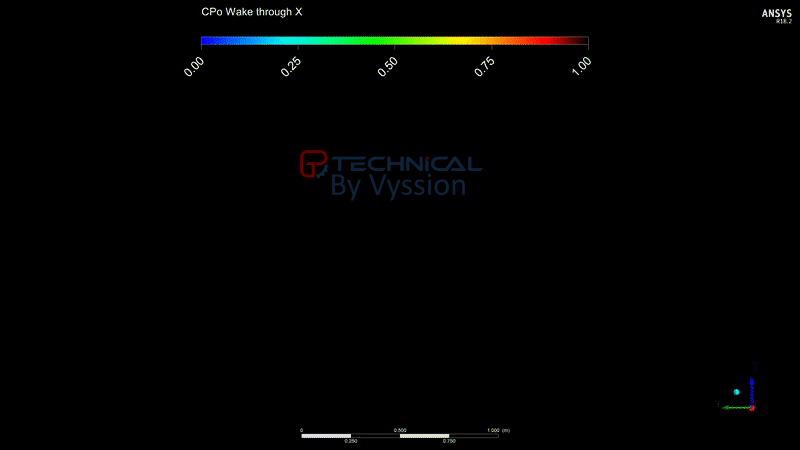How the 2019 regulations have affected the aerodynamics of F1 cars
 The 2019 rule changes were conceived to reduce the negative impact of the aerodynamic wake on a following car. On the eve of the 2019 season we take a look at the aerodynamic effect of the new regulations using a modified Perrinn F1 car.
The 2019 rule changes were conceived to reduce the negative impact of the aerodynamic wake on a following car. On the eve of the 2019 season we take a look at the aerodynamic effect of the new regulations using a modified Perrinn F1 car.
Ahead of 2017 the F1 bodywork rules were significantly changed with the sole intention of making the cars faster and more “spectacular”, and while they arguably achieved these goals (some will say the fuel and tyre saving in the race ruins the spectacle anyway) it was to the detriment of wheel-to-wheel racing, which suffered in 2017 and 2018 compared to previous seasons, even with the rear wing DRS overtaking system. Ross Brawn’s Liberty Media funded overtaking research group under the direction of Pat Symonds and Jason Somerville, along with the FIA’s head of single seater matters, Nikolas Tombazis, identified the multitude of flaps and turning vanes on the front wings, and the outwash they produced, as a key contributor to the wake of F1 cars - increasing the width of the wake (the effective width of the car) and reducing the aerodynamic performance of a following vehicle. To try and reduce the aerodynamic loss experienced by a following car a number of changes were made for 2019, including a considerable simplification of the front wing and front brake ducts, as well as increasing the height and width of the rear wing. A more detailed description of the bodywork changes can be found in earlier articles:
In this study we take a first look at how the 2019 front and rear wing dimension changes affect the aerodynamics of F1 cars using a modified version of the 2017 Perrinn open-source F1 car. Modifications to the car include the addition of the halo cockpit frontal protection device, as well as some simplification to wheels and internal flows to reduce the total mesh count (the internal geometry of the baseline Perrinn is not wholly accurate anyway).
For continuity the same wing profiles (the 2-d aerofoil shape) were used for this set of 2019 wings as the original Perrinn model, with the geometry morphed into a 2019 legal shape, so there are only 4 elements on the front wing. CFD was performed using Ansys CFX because of its greater robustness to highly skewed cells than Fluent typically allows for. Overall mesh quality was kept below what would otherwise be deemed as “unacceptable” by ANSYS’s own recommendations (i.e. max skew < 0.98 ) and there are some local refinement inaccuracies in capturing highly curved surfaces, beyond growth rates being quite high, all in the name of minimizing cell count as much as possible. Prism layers were kept to an “acceptable minimum” under the assumption that wall functions would be able to compensate for the lack of boundary layer profile resolution. We are CFDing it on regular desktops and Vyssion’s “perfectionist” OCD is running rampant with the simplifications he had to…. WiiTYiihd709uah...fne8LQauic..21hjGHBkd…. No!! Stop!! Vyssion!! Its fine!! Okay? Give me the keyboard back!! They get it… Okay?? You did as good a job as you could with the tools we have…. geez… Yes, we know you’re a good little CFD boy… Go mesh something...
The effect of the 2019 wings
Much of the talk prior to the 2019 season was that the 2019 regulations would reduce downforce compared to 2018, with the loss predicted to cost teams around 1.5s per lap; in this study though the total downforce of the car did not change (much, and certainly not by more than our confidence* in the absolute forces), albeit the distribution of downforce has been significantly affected. The front and rear wings both gained a significant quantity of downforce when compared to the 2018 car, owing to their greater planform and total surface areas, however, the underbody lost a large chunk of downforce as the loss of the outwashing elements on the front wing mean the front tyre wake is allowed to pass under the floor.
The front wheels are also producing more lift, as more air is passing over them rather than around. Predictably, as the rear wing is taller in 2019 and as the endplate louvers have been lost, the drag of the rear wing increased quite significantly relative to 2018. The only positive of loss of the outwash around the front tyres is that the rear wheel drag has been reduced.
* “confidence” does not mean we don’t trust the results per se, but mesh fidelity will affect the reported forces, we have maxed the mesh we can safely run given our hardware so forces can only be given to within 5-10% - we’re happier to present deltas.

It should be noted that the Perrinn is not as fully developed as an actual F1 entrant and so the measured effect within teams will differ from these results; probably quite substantially. The teams are also trying to recapture the outwash around the front wheels with clever designs which may sacrifice total downforce from the front wing, but should improve downforce produced by the floor.
Talking about downforce produced by the floor, the plot below of Cpz (the pressure on the surfaces acting normal to the z axis, i.e. downforce) shows how downforce under the floor is reduced in the 2019 case, not only are peak loads at the floor leading edge and diffuser throat reduced but so too is pressure along the whole length of the floor. This is because of the egress of the low total pressure (Cpo) zone from behind the front wheels under the floor. This is the same phenomenon which causes downforce loss in a wake, only localised from the car’s own front tyre.

The egress of the front tyre wake is really visible when when looking at a slice through the flow field near the ground. So too is the effect of the 2019 (top) rule change on the width of the wake aft of the car, the loss of outwash around the the front wing means the wake stays only just wider than the car over its length and is pulled into a more conventional teardrop shape by one car length back. Whereas the 2018 car (bottom) wake is almost twice the width of the car at the same point.
This was the real intent behind the 2019 rule change so, from this case at least, it would be expected that the loss of downforce when following should be reduced in 2019. Will this lead to an overtaking extravaganza in Melbourne? Maybe not as the nature of the track doesn’t naturally lend itself to passing maneuvers, but it should allow drivers to follow more closely, which coupled with harder and less temperature sensitive tyres could make for a more exciting race than last year (discounting safety car position changes).


XY aligned slices of total pressure coefficient under 2019 car (top) and 2018 car (bottom).
Looking through transverse slices through the car shows the change in the shape of the front tyre wake with the 2019 wing (top) but also how the increased height and downforce from the rear wing helps to pull the wake upwards (the mushrooming phenomenon). The Y250 vortex has not really been affected by the change, probably because the wings are the same towards the centre of the car, but the loss of strakes, cascades and flaps makes the wake of the front wing “cleaner”. The wider front wing and greater downforce creates a strong upper endplate vortex which passes along the length of the car, unfortunately rotating in a way which pushes airflow back towards the underbody along the car (which can really be seen in the lambda2 picture below).

Animated slices of total pressure for 2019 car (top) and 2018 car (bottom).
As described above the 2019 upper endplate vortex is incredibly strong and can be seen along the outer side of the car, which is rotating in a direction which is pushing air under the car. The higher downforce rear wing also produces a huge tip vortex compared to 2018, and this has already shown in testing with more contrails visible than previous years.

Yawed flow
Up to now all results presented are for straight ahead conditions but F1 cars are never driving in perfectly aligned flow, with wind and yaw through corners meaning flow crosses the car. Peak downforce is required when the car is cornering, so a 4° average crosswind was added to the cases to see how non-linear flow affected the 2018 and 2019 cars.
Immediately obvious in the 2019 case (top) is the high level of asymmetry compared to the 2018 car (bottom) particularly on the windward (upwind) side of the floor. The asymmetry doubles the rolling moment of the car from the crosswind compared to 2018. Interestingly the leeward (downwind) side of the floor produces a bit more downforce at the leading edge than the straight ahead case, as the right front tyre wake is blown outboard. The 2018 car by contrast is much more symmetrical, and is much closer to the straight ahead case over the length of the floor. The exception being the rear diffuser which is producing less downforce than when the flow is straight ahead.


Z direction pressure coefficient (downforce) on floor of 2019 car (top) and 2018 car (bottom) with a 4° crosswind.
Again looking at the slice of total pressure near the ground shows just how badly the front tyre wake is encroaching on the underbody on the windward side for the 2019 car, blowing all the way across the floor into the far diffuser channel. By comparison the 2018 car front wing maintains the outwash effect meaning the front tyre wake is still being pushed outboard by the front of the floor. This version of a 2019 car would certainly be a lot less predictable for a driver than the 2018 car, and teams will have been using all their expertise and experience to recapture the outwash, both from the front wing and bargeboards, to create a more stable platform.


XY aligned slices of total pressure coefficient under 2019 car (top) and 2018 car (bottom) with a 4° crosswind.
Again the transverse slices of total pressure show how different the aerodynamics of a 2019 car are compared to the 2018 regulations in yaw.


Animated slices of total pressure for 2019 car (top) and 2018 car (bottom) with a 4° crosswind.
Future studies
This study features a very basic interpretation of the 2019 wings and the results are stark when compared to the 2018 wings. From launch a number of cars featured less conventional front wing concepts, particularly the Alfa Romeo, Ferrari, and Toro Rosso efforts and plans are already afoot to reproduce the intent of these wings. The bargeboard area of the Perrinn is also incredibly simple when compared to the 2019 cars, which given the front wing change are being worked ever harder to stop the front tyre wake encroaching on the underbody. The 2019 rear wing also produces a significant amount of drag compared to it’s 2018 counterpart, and the design can be improved upon in further studies.





